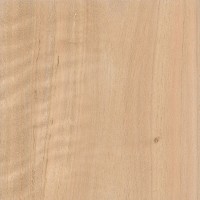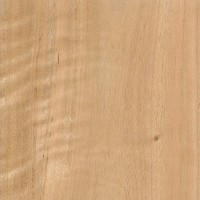 |
Common Name(s): Spotted Gum Scientific Name: Corymbia maculata (syn. Eucalyptus maculata) Distribution: Australia (coastal regions of New South Wales) Tree Size: 100-165 ft (30-50 m) tall, 3-5 ft (1-1.5 m) trunk diameter Average Dried Weight: 59 lbs/ft3 (940 kg/m3) Specific Gravity (Basic, 12% MC): .71, .94 Janka Hardness: 2,330 lbf (10,360 N) Modulus of Rupture: 20,550 lbf/in2 (141.8 MPa) Elastic Modulus: 2,867,000 lbf/in2 (19.77 GPa) Crushing Strength: 10,410 lbf/in2 (71.8 MPa) Shrinkage: Radial: 6.3%, Tangential: 9.9%, Volumetric: 16.3%, T/R Ratio: 1.6 |
Color/Appearance: No data available.
Grain/Texture: No data available.
Endgrain: No data available.
Rot Resistance: No data available.
Workability: No data available.
Odor: No characteristic odor.
Allergies/Toxicity: Although severe reactions are quite uncommon, Spotted Gum has been reported to cause skin irritation and rashes. See the articles Wood Allergies and Toxicity and Wood Dust Safety for more information.
Pricing/Availability: No data available.
Sustainability: This wood species is not listed in the CITES Appendices or on the IUCN Red List of Threatened Species.
Common Uses: No data available.
Comments: So named because the smooth grayish-white bark of the tree is shed in flakes, leaving conspicuous spots. This species was formerly in the Eucalyptus genus, and was moved to the Corymbia genus in 1995.
None available.
Scans/Pictures: There are currently no pictures of this exact wood species, but a similar species within the Eucalyptus genus is being substituted (E. globulus). If you’d like to contribute a wood sample of this specific species to be scanned, (even small pieces of veneer can be sent), please use the contact form.






Timber can be light to dark depending on the specimen. More northerly examples tend to yield darker browns with occasional stripes of orange, whilst the southern (such as from the NSW south coast) generally yield a timber of a lighter colour not dissimilar to blackbutt though slightly darker.
What sort of grain does spotted gum have? I am looking for a fine grain Aus timber that doesn’t required much grain filling to get a dead smooth surface. Any suggestions please?
Spotted Gum has a quite wavy interlocked grain soo getting straight grain will be problematic. It was/ is? commonly used for quality,strong tool handles for tools such as shovels, picks and axes but not sure if there is anyone in Aus still making them. The wood is quite waxy to the touch.
A good smooth grain hardwood is Tasmanian Myrtle
Thank you for this information, Tone, it is very helpful. What about Qld Maple? Would that be suitable?
I haven’t used that timber so I can’t comment.
Best to read the description on this site.
Spotted gum moves a lot. Its mainly used for decking here in Australia. It was used for tool handles in ye olden days. Its beautiful but terrible to work with. The grain is a nightmare. Tasmanian Blackwood (acacia) is one of the better Australian woods
Blackwood comes up a treat. Fresh finish (even on antique furniture), can even show up pinks. But those tones fade within a year. Spotted gum is alright to work but you gotta allow heaps for feeling it out, sharp spoke shave helps cause you can just change it up any which way you need to go on any bit. Push, pull, change direction, skew this way or that, leave the blade deep on one side and shallow on the other.
Myrtle Beech in Victoria yeah. Real fine grain, great for furniture and high lustrous finish. Strong too. You can still get spotted gum handles even at bunnings. You just gotta always look and sometimes they’re spotted gum. I grab sledgehammer handles if I see them.
I used a couple of spotted gum glulam (finger jointed) panels from Bunnos for a large L-shaped desk to allow me to work from home until much-desired retirement :D. It was already “prepared” as such, but I sanded down to a smooth surface quite easily and it took a danish oil very readily. I had no problems getting a good surface but YMMV of course. I noted other comments about movement but my research indicated that spotted gum is pretty stable. I initially sanded these panels then stickered them in a spare room for a couple of years before extracting… Read more »
It’s fine for a slap on top on a desk or bench. That’s what that product is for. It’s not so great for fine furniture or cabinet work. Big gaps open up
Anyone here oil spotted gum decking, exposed thinking of using Nature’s natural timber oil to keep the beautiful color of the timber we do expect it to darken a little with the use of an oil
Weather it first or it won’t accept the oil. You’ll wind up with a layer of polymerised oil “stuck” on top of the wood. You gotta let it grey out a bit before it’ll drink up the “decking oil” products.
I used spotted gum on a gate repair 2 years ago. I coated it with boiled linseed oil (which did darken it a little). It has not greyed or lost its colour.
John Partion, this may help you, spotted gum is extensively used in boat building as it can be steam bent into ribs and planking
So I am thinking of making long bow.
I am in Western Australia.
Of course hickory would be my first choice.
But may be hard to come by.
Jarrah not sure thinking it might snap.
Blackbutt?
Spotted gum?
Any suggestions
Thanks
Spotted gum is about the only Australian timber you can use to make a decent self-bow. The modulus of elasticity of other Aussie timbers is too poor. As for laminated bows, you’ll find a lot of timbers are either too brittle or too greasy, so they will either snap or you can’t get good adhesion, even with the best epoxys. That probably explains why the first Australians got so good with boomerangs and spears for the first 60,000 years or so.
I would not personally use spotted gum, it is nice and whippy, has some spring to it, but is likely to snap, I have tried many times to use it as a bow wood to no great success, also finding a piece with a straight enough grain is a nightmare. The bow wood that has worked without fail for me is a tea tree (native) such as paperbark, I sourced the timber myself though, and it’s not (that I have ever seen) available commercially.
Spotty is used in flooring, decking, garden sleepers and tool handles.